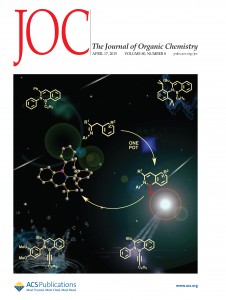 Three chemists at the Indian Institute of Technology Guwahati in India have retracted a paper from the Journal of Organic Chemistry because the “incorrect files were inadvertently used.”
Three chemists at the Indian Institute of Technology Guwahati in India have retracted a paper from the Journal of Organic Chemistry because the “incorrect files were inadvertently used.”
The article, “Room-Temperature Cu(II)-Catalyzed Chemo- and Regioselective Ortho-Nitration of Arenes via C–H Functionalization,” described a protocol to perform nitration — the addition of nitro groups onto an organic compound — using an inexpensive copper catalyst.
All three authors signed the one-sentence notice:
This article was retracted by the authors when it was discovered that incorrect files were inadvertently used in the preparation of the published paper.
Corresponding author Tharmalingam Punniyamurthy sent us this background on what happened:
By mistake the student provided un-updated file (incorrect file) that led to error in the yield. We are going to submit shortly the correct version to the same journal.
The data of the some of the compounds are to be replaced with improved results. Since the student has kept the files names as similar for both the updated and partially updated, by mistake, sent the partially updated file.
Otherwise, the manuscript (introduction, discussion, mechanism and conclusion) will be same. Only for the some of the compounds the data are to be replaced with slightly improved yields.
We’ve also reached out to the journal editor and will update if we hear back.
Hat tip: Shawn Burdette
Like Retraction Watch? Consider supporting our growth. You can also follow us on Twitter, like us on Facebook, add us to your RSS reader, and sign up on our homepage for an email every time there’s a new post.
This is definitely not a straightforward notice. It’s very opaque as it makes zero sense for someone in the field. I, and some others, don’t believe the official reason at all. The yields are already pretty high at >80% and >90% for some substrates and it would be difficult to get higher isolated yields. In such a case, retraction is not appropriate if everything else is okay, and a small correction (that improves the paper) should be considered.
But this paper is a bit strange, with 20% catalyst loading and 35% of iron complex as the NO2 source so if you consider both metals with iron supplying the copper, you get slightly more than one turnover based on metal… Might as well use stoichiometric copper there (which seems to work very well indeed in Table 1, entry 21). Plus, like many similar papers, even from famous American groups that publish in JACS, this is not CH activation but Friedel-Crafts substitution, maybe directed ‘Friedel-Crafts substitution’, but still a reaction that has been known for 100 years. The substrate is already pre-activated for substitution in the ortho or para position by the amine, and in a lot of the substrates the para position is blocked. Still, there is selectivity in some substrates where the para position is free, and the yield is higher than the statistical 66%… but the really high metal loading does make me comprehensive about the catalysis claim. It really comes down to the yield. And it is high enough to infer catalytic activity from the results, at least for some substrates. Still, it’s really easy to get error in yields.
Personally, if I was the reviewer, I would reject it unless they managed to get their metal loading down a lot, say to 5 or 10% at most, even for Journal of Organic Chemistry, as there are just too many sources of error to make the claim for CH activation catalysis at these high catalyst loadings and it’s not that novel of a reaction.
Out of curiosity, as I spent a bit of time looking at the paper, I really wonder what will happen in the end in this strange case.
2 retracted papers by same author
http://www.sciencedirect.com/science/article/pii/S0022169414000973
http://link.springer.com/article/10.1007%2Fs00704-014-1102-6